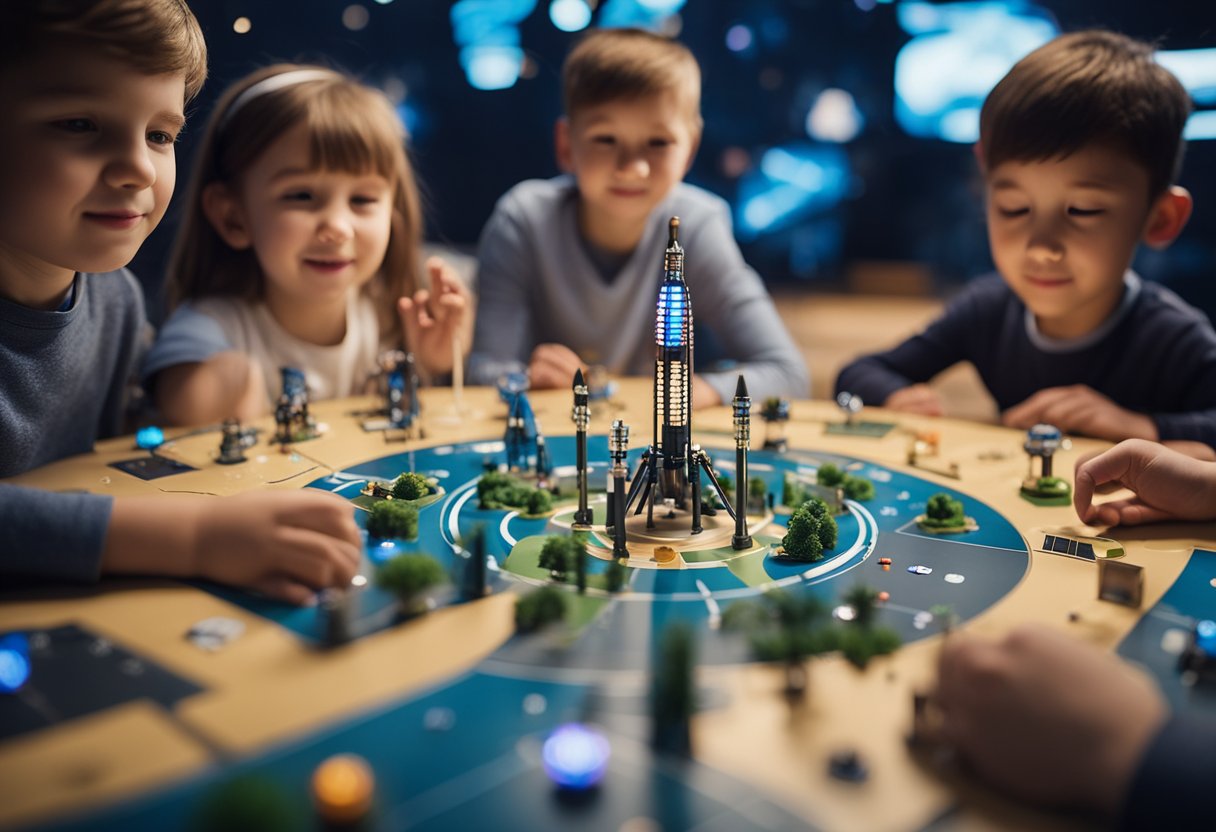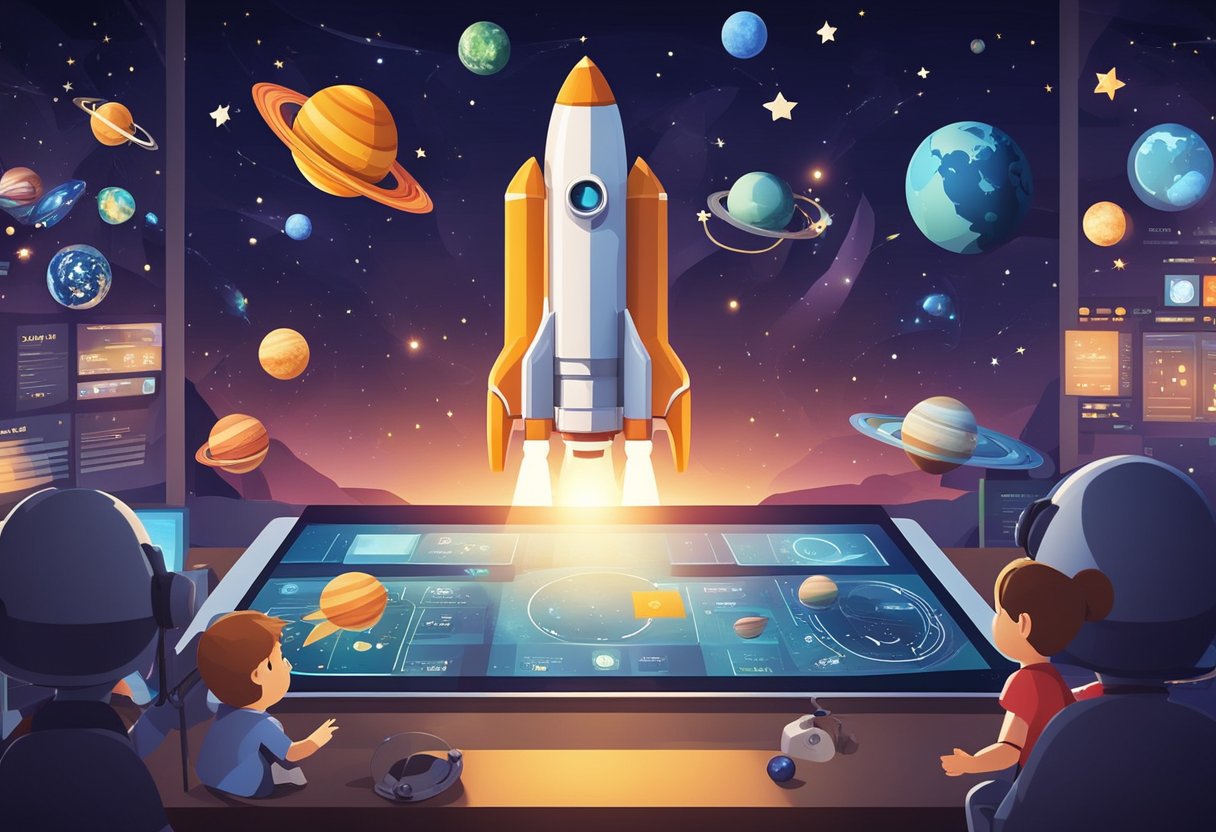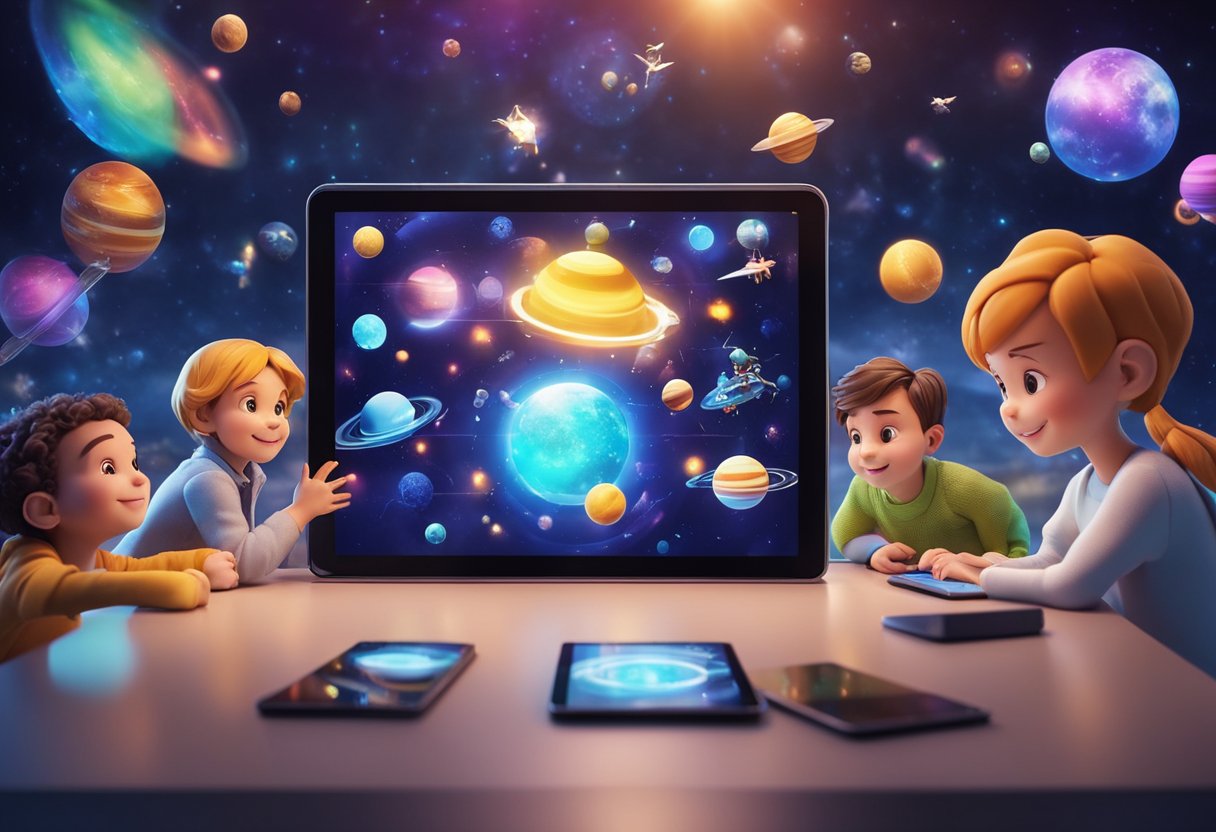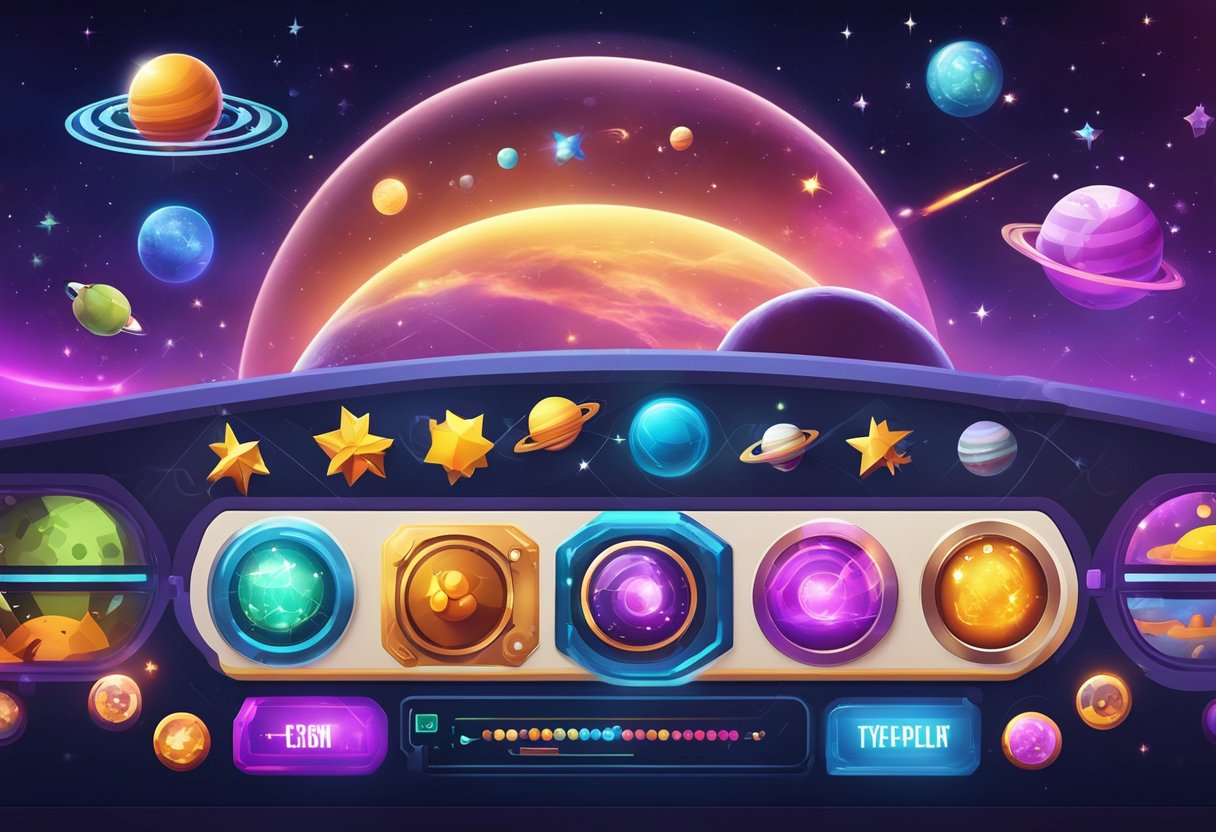
Interactive space games for children offer an engaging way to explore the cosmos from the comfort of home. By combining educational content with entertainment, these games allow us to introduce young learners to the mysteries of space, the solar system, and Earth science. They serve as an excellent tool to pique children’s interest in science, technology, engineering, and maths (STEM), while also helping them understand complex scientific concepts in an enjoyable and interactive environment.

With a plethora of space-themed games available, created by organisations like NASA and educational game developers, we can guide children through a variety of missions and activities designed to simulate space exploration. These games often include building and launching spacecraft, solving puzzles related to the space environment, and learning about different planets. As technology evolves, these games become more immersive, enabling children to experience aspects of space travel and earth science in a more impactful way.

Interactive space games offer a captivating way for children to learn about astronomy and grasp complex scientific concepts. These games can make the exploration of space, planets, and the broader solar system both educational and entertaining.
Interactive games are integral in the educational journey of students interested in space and science. By allowing children to virtually explore different planets and moons, these games foster an early appreciation for the complexities of our galaxy, including the Milky Way, and beyond.
Games like NASA Space Place provide a platform where children can engage with intricate astronomical phenomena through play. Here, concepts like orbiting planets in our solar system are not just read about, but experienced first-hand as students navigate a Mars Rover or learn about the energy output of stars.
Our understanding of space benefits tremendously from interactive experiences that simulate space missions. For instance, children might construct a model of the solar system, or simulate the conditions necessary for life on other planets. Technologies used by NASA become accessible as children use simplified versions of these tools in their gaming experience, prompting interest in engineering and technology.
Games like those found on NASA Kids’ Club can also elucidate the science behind space exploration. These activities demystify the roles of different NASA departments, illustrating how science, technology, engineering, and mathematics (STEM) interconnect in the realm of space exploration.
We find that when children interact with these games, it’s not solely for entertainment. These platforms often incorporate structured learning objectives that align with educational curricula. This fusion of fun and learning helps to inspire the next generation of scientists, astronauts, and engineers.
While exploring through gameplay, children can also become familiar with futuristic concepts. On sites like SpaceVoyageVentures.com, they get insights into the evolving field of space tourism. Though currently in its infancy, they learn about what tourism might look like in space, which prompts them to dream and maybe one day partake in such adventures.
Through this interactive digital play, we can cultivate a sense of curiosity and excitement in children about the universe. By using these educational games, we provide students with a solid foundation for understanding not only our solar system and the stars but also the potential for future space exploration and travel.
Interactive space games offer an engaging way for children of all ages to learn about the cosmos. They can ignite a child’s imagination and help them grasp complex scientific concepts through play.
For our youngest aspiring astronomers, NASA Space Place provides a variety of educational games that blend entertainment with learning. Activities here are designed to introduce basic space and Earth science concepts in a playful manner. Children can pilot a Mars rover, learn about solar energy, or even write their own intergalactic adventure. Tailored for young learners, these games use simple mechanics suited for their developmental stage.
For students a bit more advanced in years and knowledge, games need to cater to their growing skills and curiosity. The Crew: Quest for Planet Nine bridges the gap between play and education effectively. Catering to children aged 10 and older, this game creates a thrilling experience where players partake in a space expedition to solve interstellar mysteries.
Furthermore, children eager to know more about the future of space exploration can visit SpaceVoyageVentures.com. Here they can explore the potential of space tourism and even discover the kinds of journeys that are nearly available for the more adventurous souls.
We’ve put together an insightful look into NASA’s educational games designed to engage children in space science through interactive experiences that combine fun with learning.
At NASA Space Place, we find a fantastic array of games that channel the excitement of space discovery into interactive learning. Children can embark on missions to explore distant planets and understand scientific concepts through play. They immerse themselves in activities like ‘Relay: A Laser-Based Space Communications Game’ and ‘Explore Mars: A Mars Rover Game’. Each game integrates aspects of science, technology, engineering, and maths (STEM) to enrich their knowledge while they’re having fun.
NASA Home and City illustrates how space technology improves our daily lives. We guide children through virtual environments demonstrating the crossover between life on Earth and innovations developed for space. Kids encounter NASA’s influence on home and city environments, showcasing applied science and engineering in relatable settings. Through this interactive experience, the importance of NASA’s technology and its impact on our lives are made clearly visible to a young audience.

Interactive space games provide an engaging platform for children to learn key scientific concepts. These games present complex ideas in a simplified manner, enabling young minds to grasp fundamentals of astronomy and physics through immersive experiences.
Our solar system is a fascinating subject for children, and interactive games make the education process both fun and informative. They can learn about the eight planets that orbit our Sun and the characteristics that make each one unique. For instance, the game Solar System Switch-a-Roo helps kids understand the order of the planets and key information such as:
Games like these solidify the understanding of our planetary neighbours and enhance the conceptual retention among the young learners.
Beyond our solar system lies a vast expanse called the universe, teeming with galaxies, stars, and other celestial objects. Through interactive games, children discover the Milky Way Galaxy which is home to our solar system, and they learn that it is just one of the billions of galaxies in the universe. Educational games bring to light the monumental scale of the cosmos and the place of our solar system within it. For example, NASA Space Voyagers encourages children to explore different aspects of space, such as:
By engaging with interactive games, children can feel as though they’re on a virtual space voyage, grasping the science behind the phenomena that captivate us all.

Interactive space games provide a virtual platform for us to engage children with the core components of STEM: Science, Technology, Engineering, and Mathematics. Through play, young learners can encounter complex concepts such as Earth science and climate change in an intuitive and enjoyable manner.
Technology and engineering are at the heart of space exploration. By designing games where children have to navigate spacecraft, they naturally learn about the engineering challenges involved in space missions. A game might simulate the design and launch of a rocket, teaching the principles of aerodynamics and propulsion. Children may engage with exciting missions, such as the ones showcased on SpaceVoyageVentures.com, to comprehend the technological feats required for both existing and hypothetical space tourism ventures.
Games centred around science and Earth science foster curiosity in understanding our planet’s climate and other planetary systems. A game that includes climate change scenarios, for instance, would encourage players to think critically about the Earth’s ecosystems and the impact of human activities. Experiments with virtual ecosystems and the management of resources on a spacecraft can inspire a deeper appreciation for the complexity of scientific discovery in the context of sustaining life in outer space.

In this section, we’ll examine some of the pivotal NASA missions that have expanded our knowledge of space, as well as look ahead to what future space exploration may hold.
Voyager Probes: In 1977, we launched the Voyager probes, which have ventured beyond our solar system, sending back invaluable data about the outer planets and interstellar space.
Mars Rovers: The exploration of Mars has been propelled by our rovers, including Spirit, Opportunity, and Curiosity. Their analyses have unveiled Mars’ geology and past water activity, enriching our understanding of the red planet.
Hubble Space Telescope: Since 1990, the Hubble Space Telescope has revolutionised our view of the universe. It has captured stunning images of distant galaxies, nebulae, and stars, contributing greatly to our knowledge of the cosmos.
Apollo Moon Landings: One cannot forget the Apollo missions, especially Apollo 11 in 1969, which marked the first time humans set foot on the Moon, a cornerstone in space history.
Artemis Program: We are now preparing for the Artemis program, aimed at returning humans to the Moon and establishing a sustainable presence by the end of the decade.
Martian Crewed Missions: Looking further ahead, missions to send astronauts to Mars are in the conceptual stages, promising to be the next giant leap in space exploration.
Space Tourism: Ventures such as SpaceVoyageVentures.com indicate an intriguing future where space tourism is not just science fiction, but a nearing reality.
International Collaborations: The collaborative efforts between countries and private entities will likely accelerate our exploration and understanding of space, bringing new perspectives and innovations.

We must equip our children with a profound understanding of their planet, especially in the context of environmental awareness and climate change. Through interactive space games, they can explore Earth science in a compelling way, bringing them closer to the stars and beyond while anchoring their knowledge in the reality of our environmental challenges.
The Climate Time Machine, a pivotal component of NASA Climate Kids, allows young minds to witness how Earth’s climate has altered over time. By engaging with this game, children can visualise the consequential impact of climate change. Players can see for themselves the significant transformations our planet has undergone, from retreating glaciers to sea level changes, through a series of interactive timelines.
To truly grasp the magnitude of environmental issues, we provide children with interactive experiences about Earth’s climate. It’s not just about the concern for our environment; it’s about understanding the science behind the atmosphere, the effect of greenhouse gases, and the significance of the sun as Earth’s primary energy source. These comprehensive games educate on these concepts, helping to foster a generation that is better informed and ready to tackle the pressing issue of climate change.

We recognise the importance of providing interactive space-themed games that cater to a diverse group of young enthusiasts. Our goal is to offer educational content that bridges language barriers and fosters inclusion.
Our commitment to inclusivity is evident in the array of games that are offered in Spanish. It’s essential that children and students who are Spanish speakers have access to educational space activities. NASA’s Space Place is a prime example, providing multiple interactive experiences that are available in both English and Spanish. These games not only make learning about space fun and engaging for kids but also support bilingual education efforts.
We understand the immense benefits that engaging with science and technology can bring to children’s education. Through space-themed activities and projects, students can develop their understanding of key concepts in science, such as the movement of planets or the nature of volcanoes, while applying their skills in technology and engineering. Let’s explore some dynamic ways to bring the cosmos into the classroom.
Create a Spinning Solar System: An excellent project for budding scientists is to build a model of the solar system. Students will need a paper plate, coloured construction paper, pebbles, and black and silver craft paint. This project helps children grasp the motion of celestial bodies and reinforces their knowledge of the solar system. For detailed instructions, visit this guide on creating a pinwheel galaxy.
Make a Topographic Map of a Celestial Body: Crafting a topographic map allows students to delve into the surface features of planets or moons. It’s an exercise that combines art, science, and a touch of engineering. This activity can be a stimulating way to discuss the surface of extraterrestrial bodies, such as the volcanoes on Mars. Instructions for this exercise can be found on NASA’s educational page for creating a topographic map.
Launch a Rocket from a Spinning Planet: Group activities like launching a mock rocket can introduce the basics of physics and engineering to children. This activity can be both exciting and educational, providing hands-on experience with the principles of motion and force. Details about how to conduct this experiment are available at NASA Space Place.
Space-Themed Board Game Session: Incorporating play in education through a space-themed board game can enhance collaborative skills and ignite interest in space exploration. A board game session gives children a chance to learn about stars, planets, and other celestial phenomena in an interactive manner. For creating your own space-themed board game, consider this resource on space activities for kids.
In addition to these activities, we mustn’t forget the expanding realm of space tourism, documented at SpaceVoyageVentures.com. Although in its nascent stages, the website offers a glimpse into the future possibilities of space travel. It’s a useful tool to discuss current and near-future scientific advancements with students, fostering an aspirational outlook towards their role in technology and space exploration.
In our exploration of interactive space games for children, we’ve found a variety of offerings that blend excitement with education. Digital games can be a vibrant addition to a child’s learning repertoire, often incorporating game mechanics that reinforce technological literacy and educational content.
NASA Space Place provides a hub of space-themed games that are both fun and enlightening. Children can control their own space missions with games like Explore Mars: A Mars Rover Game, giving them a sense of the challenges and triumphs involved in space exploration.
Moreover, Common Sense Media lists a curated selection of outer space apps and games that are child-friendly. These games not only entertain but also inform, with reviews indicating an abundance of information available for young astronomy enthusiasts.
For a more narrative-driven experience, children can craft their own stories with the Write Your Own Zany Adventure Story game, prompting them to use their imagination and improve their storytelling skills.
Here’s a succinct breakdown of some key offerings:
Games for Educative Fun: DSN Uplink-Downlink and Space Volcanoes allow kids to learn about complex space concepts through interactive play.
Astronomy Tools for Kids: Apps like What’s in Space? cater to aspiring astronauts aged 6 and up, turning learning about the cosmos into an engaging activity.
Strategy and Teamwork: NASA Space Voyagers: The Game emphasises the importance of strategy and teamwork in space missions.
With these tech-based games, we’re nurturing a generation proficient in technology and hungry for knowledge. It’s through these interactive platforms that they absorb scientific principles and the workings of our universe—without feeling like they’re in a traditional educational setting.

In today’s rapidly advancing world, keeping pace with the latest space games is a thrill for many children intrigued by the cosmos. Our approach to staying current with these updates includes a multifaceted strategy, ensuring that we present the most engaging and educational experiences in space exploration.
Firstly, we regularly check NASA Space Place which offers numerous space-related games specifically designed for children. These games often incorporate elements from actual NASA missions, allowing young users to learn through interactive play. The website updates periodically with new games that reflect the latest discoveries and technological innovations from NASA.
Furthermore, we leverage social media and online forums to track announcements of new releases. Game developers and educational sites frequently post updates about upcoming games or enhancements to existing ones. These platforms serve as a rich source of information for parents and educators looking to inspire a love of space and technology in their children.
To ensure that children have access to the most recent technology, we keep an eye on emerging trends in educational gaming. As digital platforms evolve, games become more interactive and immersive, potentially offering virtual reality (VR) experiences that simulate space travel.
For those keen on a glimpse into the future of space exploration and the prospect of space tourism, SpaceVoyageVentures.com is an intriguing resource. This site documents the potential for future space trips and the current options approaching fruition, providing a visionary aspect to space games and educational content.
By keeping our finger on the pulse of new games, updates, and technological trends, we ensure that the children remain at the forefront of space exploration, digitally engaging with the universe from their own homes.

In this section, we answer common queries surrounding online space games that can enrich children’s knowledge. Our focus is on educational, interactive, and immersive experiences within the realm of space exploration and astronomy for young audiences.
For an enriching learning experience, NASA Space Place provides a range of interactive games and activities. These are designed to engage children with space and Earth science in an enjoyable and educational manner.
Games that have received high praise for their interactivity and celestial themes include those from Common Sense Media’s list of best outer space apps and games. They offer exploration and observation of the stars catered to young players.
Yes, PBS Kids offers a selection of free space-themed games. These games combine fun with education, allowing children to learn about space in an interactive setting.
While most space simulations are designed for older audiences, we’re seeing a growing trend in creating age-appropriate simulations that still offer a realistic experience. Keep an eye on new releases that cater to younger audiences interested in exploring space.
Various online games teach children about the solar system by incorporating interactive missions and educational content. A popular option includes various hands-on activities from websites like NASA Space Place, combining gaming with factual science education.
NASA’s children’s program includes a variety of games and interactive experiences on their Space Place platform, designed specifically to make space science accessible and enjoyable for children. This contributes significantly to space education through an engaging, game-based learning approach.